The Fariña Files | home
Time Line | Cast of characters | Cast of Characters 2 | Cast of Characters 3 | This One's For Mimi | The Books - a guide | Newport Folk Festival 1965 | Dick and Mimi - where they were, how they got there, and what they did for three days | Newport Folk Festival - July 22, 23rd | Newport Folk Festival - Saturday, July 24th | Newport Folk Festival - Sunday, July 25th | Photos and Sources | Annotated Discography | Four for Fun | Web site bibliography | Favorite Links | Contact Me
Cast of Characters 3
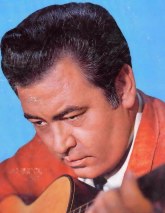 |
Martin, Grady : Nashville session guitar player extraordinaire. Starting out as a fiddler with Big Jeff Bess and His Radio Playboys, he shifted quickly to guitar with the Arkansas Cotton Pickers, and later played with Little Jimmy Dickens. Martin was also playing in the grand Ole Opry house band at the time of Hank William's Opry debut in 1949. He moved the session work in Nashville in the 50s, working with Brenda Lee, Lefty Frizzell and Conway Twitty among at least hundreds of others, and being described on one of his Decca solo albums (where he also recorded with his session band, The Slewfoot Five) as a virtual prisoner to legendary producer Owen Bradley's recording schedule. His guitar playing is responsible not only for the acoustic work on Marty Robbin's 1959 hit, "El Paso", but also for the electric guitar on Johnny Horton's 1956 hit "Honky tonk man". He led the studio band and was involved with the NY sessions for Joan Baez's Richard Fariña -produced, but never released rock and roll album in March of 1966. He's also credited for leading the band (and the guitar solos) on "Morgan the Pirate". Grady Martin played in Willie Nelson's back-up band until he retired in the mid-90s.
|
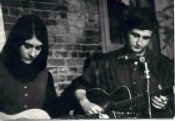 (photo : w/ Mimi at Club 47, Feb.
1966 ; photo by Dick Waterman)
|
Shiver me timbers !, (2003, privately pressed & sold at his concerts, with a cover by von Schmidt), Beautiful isle of somewhere (live, 2003, Radiobremen) and Private astronomy : a vision of the music of Bix Beiderbecke (2003, Edge/Deutsche Grammophone) . (see also Muldaur discography )
|
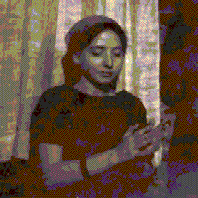 (photo by Dick Waterman: Club 47, Boston, onstage with Dick and Mimi, Feb.'66 )
|
|
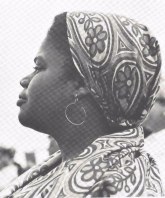 photo by David Gahr, 1965
|
Reagon, Bernice Johnson - Originally from Atlanta, always active in Civil Rights, she first came to light singing with the Freedom Singers in the early '60s, moving to a solo career in 1964 after having Toshi, her first child (and now a performer in her own right), and performing at the 1965 Newport Folk Festival, first at Friday's Group Singing Style workshop, and then again on Sunday afternoon at the New Folks concert ( joining in the rain for the Fariñas last song, and then performing solo right after). She put out a solo album on Folkways in 1965, was marketing her own records from her home. In 1968, she put together the Harrambee Singers, performing songs about the political struggles of black people. By the early 70s, she was working as vocal director at the Black Repertory Company in Washington, D.C. and in 1973, founded Sweet Honey In The Rock , an all-woman, acapella group established in the roots of the 19th century Southwest Georgia choral tradition. She has also composed and performed film scores, won a Presidential Medal, and is currently a Distinguished Professor of History at American University as well as Curator Emeritus at the Smithsonian Institute's National Museum of American History.
|
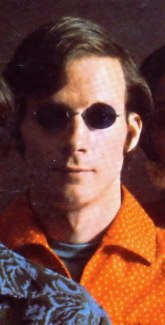 photo by Charlie Frizzell, from VRS-9234, 1966
|
|
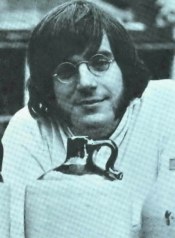 (photo by Henry Diltz, from the 1967 Lovin' Spoonful tour book)
|
Sebastian, John : Born NYC, 1944, son of John Sebastian (Puglese), a classical harmonica virtuoso and songwriter (and author of "J.B.'s harmonica", a song about his son). He grew up in Greenwich Village, studying piano, then harmonica (how could he not?), and guitar. He was a fixture on the NY folk club scene from the late 50s on, playing harmonica everywhere, backing anyone who'd give him the stage space. He apprenticed to Lightin' Hopkins in the early 60s, and "learned to play exactly like him, right down to the mistakes". Always a buddy of Geoff Muldaur and Fritz Richmond of the Kweskin Jug Band, in 1962 Sebastian was introduced to Canadian folkie and oldies fiend Zal Yanovsky by folk materfamilias Cass Elliott, and the two were temporarily joined with Cass and Denny Doherty in the Mugwumps, whose producer kicked Sebastian out for trying to instigate Zal's exit from the band, which promptly broke up anyway. In 1964, he was recruited into the Even Dozen Jug Band, Elektra's instant answer to Vanguard's Kweskin outfit, performing as John Benson along with Maria D'Amato, David Grisman, Josh Rifkin, Stephan Grossman, Steve Katz, Peter Siegel and Danny Lauffer on jug. Sebastian and Yanovsky combined their love of jug band music and electric rock and formed the Lovin' Spoonful in late 1964, becoming the house band at the Night Owl Cafe in NYC. In October, 1965, their first single, "Do you believe in Magic" became the first of a string of hits that would take them into 1968. The Spoonful played the Newport Folk Festival in the summer of 1966, and during this period, he continued doing sessions, playing for Bob Dylan on Bringing it all back home, on Fred Neil's first two albums, Tim Hardin's first two, the Door's Morrison Hotel, The Blues Project (the Eleltra anothology, not the Al Kooper band) and a host of others.
Following the breakup of the Spoonful in 1968, Sebastian set up camp in California, made an unbilled and now famous LSD-laced performance at Woodstock in 1969, and made 5 albums for Reprise in the 70's. (A Footnote : MGM tried to lay legal claim to his first solo album on the basis of 1. owning Kama Sutra, the Spoonful's label, and 2. having released his single, She's a lady/ Room nobody lives in, on Kama Sutra in 1969. According to news articles of the time, MGM pressed their claim by releasing his solo LP, using the single masters and, according to courtroom testimony, literally pirating the remaining tracks from a vinyl copy - released as John B. Sebastian, SE-4654 on MGM in 1970. The courts quickly ruled in favor of Reprise and the MGM version was deleted pronto.) After that, he popped up here and there when any of his friends recorded (such as Rounder's Music from Mud Acres, when just about all his friends appeared), he toured constantly in the 70s, but then stayed out of solo appearances and recording work until Shanachie's Tar Beach in 1992. Since then, he's popped up more often, recording either solo or with the J. Band on MusicMasters (1996) or the second one (with Geoff Muldaur) on Hollywood Records in 1999. He's also been seen flogging a multi-volume Time/Life collection of folksongs on tv in the nether hours. While always a welcome sight, and since his voice came back (after the Spoonful were inducted into the Rock Hall of Fame, when the reunited band performed an essentially instrumental version of "Do you believe in magic?" which Sebastian happily but barely croaked along ), a welcome sound. Rhino Handmade reissued a limited edition set of all his Reprise work, followed by Reprise reissues .
|
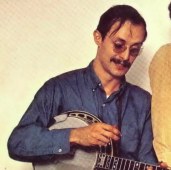 (photo by Lawrence Shustak, from VSD-2158, 1963) (photo by Lawrence Shustak, from VSD-2158, 1963) |
|
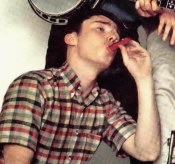 (photo by Lawrence Shustak, from VSD-2158, 1963)
|
I'd love to know where he is.
|
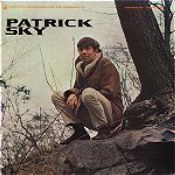 |
Sky, Patrick - A great singer/songwriter from Liveoak Gardens, Georgia, his appearances in 1965 were his first at Newport. He appeared at Saturday's Contemporary Songs workshop and again at Sunday's New Folks concert as the 8th performer. Another performer from the Vanguard stable, he released his first album Patrick Sky in the summer of 1965 and followed this with a three song contribution to Elektra's Singer Songwriter Project and his second Vanguard release, A Harvest of Gentle Clang, in September of 1966. Some of his songs were soon to become staples of the Basic Folksinger Kit, particularly "Many a Mile" and "Separation Blues". Fellow Cree Indian Buffy Sainte-Marie was to champion Sky and his songs, while both spotlighted the plight of Native Americans. Sky's interest in folk music was almost academic in nature, although his sense of humor was more directly traceable to W.C. Fields. He possessed a frequently-mined Rabelaisian vein, but never quite had the interest to push his career in a commercially successful direction. Far more interested in ancient Celtic music and instruments than tap-dancing in Vegas, his recording career wandered from Vanguard to MGM (two albums in the late 60s), to Verve/Forecast (two, in 1968 & 1969), then a gap until 1973's notorious Songs That Made America Famous on his own Adelphi label, and one on Leviathan in 1975, Two Steps Forward and One Step Back. As far as I can tell, his last recording, for the mostly Celtic music Shanachie Records, was Through a Window in 1985, although he has produced recordings of other traditional musicians and even wrote & produced a country music play in the mid 1980's, The Dixie Dewdrop, on the life of former mule wagoner and early Grand Ole Opry star Uncle Dave Macon. Sky, who now lives in Chapel Hill, NC, basically retired to study Celtic harp and Irish uilleann pipes. He still does occasional concerts and old-time music festivals, particularly in the Southeast.
|
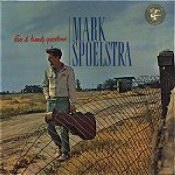 |
Spoelstra, Mark - A very early amateur of Joan Baez (pre-fame, California teen years), Spoelstra, a guitarist (12 string) and songwriter, arrived in NYC in the fall of 1959, and was supported by Sonny Terry and Brownie McGhee, whom he'd known in California. John Cohen of the New Lost City Ramblers got him a contract at Folkways Records, where he released two albums (and, he swears, a single) of traditional and blues songs. His career was interrupted by a two-year stint at alternative service back in California, with occasional (and officially approved ) concerts. He moved to Cambridge and began doing original songs, leading to two LPs for Elektra - the first, Four and Twenty Questions featured not only original songs, but liner notes by Dick Fariña; the second, State of Mind, was released the following year. He also released an album on Fantasy (This House), in the 70s. He performed twice at the 1965 Newport Festival, once at the Broadside workshop, and again at New Folks on Sunday.
|
 |
Thorndyke Pickledish Choir - On here because I wanted to see if anyone else knew of them (and if you can't do this stuff on your own web site...). Sang "Walter Wart, parts 1 and 2", which got played on folk music radio shows in the mid-60s and nowhere else. Released as a single in 1966 by A&M Records (single no. 828), it went nowhere on the charts but went straight to the hearts and homes of a select few. It featured someone sounding remarkably like Kermit the Frog, singing such lyrical finery as " Oh Walter Wart, we know you got soul, who's that swimming in punch bowl? It's far out Walter Wart, the Freaky Frog..." . He/they/it was not known to have performed anywhere muchless at Newport in 1965, although a possible cameo backstroke across the New Folks concert stage should never be ruled out.
|
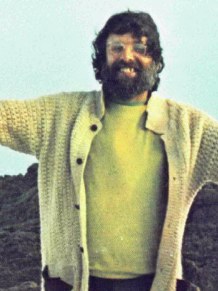 |
von Schmidt, Eric : Probably the paterfamilias of the Cambridge folk scene (as was Dave Van Ronk in NYC), von Schimdt grew up in Westport, Connecticut and is the son of Harold von Schmidt, a noted illustrator best known now for his western scenes. Aspiring to become an illustrator at an early age, he attended Staples High School in Westport, but was really educated (as most sensible people are) outside of school in his father's studio, at Leadbelly's recorded feet, and anywhere he could pick up enough information to play anything on anything. Starting out on ukelele, he soon graduated to guitar and began performing traditional blues. Drafted in the early fifties, he came back home and was awarded a Fulbright Scholarship, which he used to study painting in Italy. Returning to Cambridge in 1957, he did the club circuit, wrote songs (and was world-class at spontaneous, alcohol-driven musical creations on stage). In 1961, he and Cambridge fixture Rolf Cahn did an album for Folkways, followed in 1963 by his own first solo album on Prestige, as well as an album put together to accompany his kid's songbook,
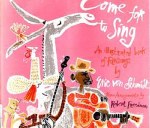 Come for to sing (w/ Carolyn Hester, Jackie Washington, Jack Elliott and Rolf Kahn; Houghton Mifflin, 1963) on the local Pathways of Sound label. All through the 60s and beyond, von Schmidt lent support and nurtured uncounted folk and blues talents, most notably Dylan, if not Fariña, although the Dylan -or more directly, Albert Grossman - connection ended up with his losing arranger credit, if not writer's credit on one of his best songs, Baby, let me follow you down, when Dylan recorded that song on his debut album 1962. He performed at the Newport Folk Festival and released Eric sings von Schmidt on Prestige, an album of all self-penned works, which featured his most-covered song "Joshua gone Barbados" as well as some of his other best works (the album also featured a pen and ink self-portrait and liner notes by Fariña). All this time he did prodigious illustrating work, doing endless (and award-winning) children's books, songbooks (including The Joan Baez Songbook), as well as the cover illustration & unpublished text illustrations for Richard Fariña's Been down so long it looks like up to me in 1966. Most of the later sixties was spent in his art studio, commuting between Sarasota, Florida, New England and the isle of St. Vincent in the West Indies. In 1969, he did Who knocked the brains out of the sky? for Mercury (which got "condemned" status from Rolling Stone, though philosophically, von Schmidt's opinion was "Hey, they reviewed it, man, whatever they said, they noticed it out of how many other albums?!") released a single from the album, performed here and there , taking a fuller tour in the early 70s prior to 1972 release of 2nd Right, 3rd Row on Poppy (and recording a second album, only released in 2002 on CD on the Tomato label). One of his main projects in the 70s was a thoroughly-researched, historically acurate, and huge painting of Custer's last stand, which got a great deal of notice in historical circles and accompanied a recounting of the tale in a U.S. magazine. He vanished until 1977's Eric von Schmidt and the Cruel Family (featuring a cover painting by himself, as well as guest appearances by Geoff Muldaur, Jim Rooney, Clay Jackson, and Billy Mundi (formerly of the Mothers and Rhinoceros). After that, he did mainly illustration work, continuing his work doing Vanguard cover illustrations (including a number of twofer reissues as well as several in their classical catalog), plus doing a number of covers for Philo records. In 1979, he and Jim Rooney got together and wrote the definitive history of the Cambridge, MA folk scene for Doubleday, Baby, let me follow you down, to which and whom this website owes a large debt. A long absence ended in 1995 with the release of the CD, Baby, let me lay it on you on the Connecticut-based Gazell label, featuring reworkings of some of his best known songs as well as back-up by Linda Clifford, his daughter Caitlin, Paul Geremia and Sam Charters. Come for to sing (w/ Carolyn Hester, Jackie Washington, Jack Elliott and Rolf Kahn; Houghton Mifflin, 1963) on the local Pathways of Sound label. All through the 60s and beyond, von Schmidt lent support and nurtured uncounted folk and blues talents, most notably Dylan, if not Fariña, although the Dylan -or more directly, Albert Grossman - connection ended up with his losing arranger credit, if not writer's credit on one of his best songs, Baby, let me follow you down, when Dylan recorded that song on his debut album 1962. He performed at the Newport Folk Festival and released Eric sings von Schmidt on Prestige, an album of all self-penned works, which featured his most-covered song "Joshua gone Barbados" as well as some of his other best works (the album also featured a pen and ink self-portrait and liner notes by Fariña). All this time he did prodigious illustrating work, doing endless (and award-winning) children's books, songbooks (including The Joan Baez Songbook), as well as the cover illustration & unpublished text illustrations for Richard Fariña's Been down so long it looks like up to me in 1966. Most of the later sixties was spent in his art studio, commuting between Sarasota, Florida, New England and the isle of St. Vincent in the West Indies. In 1969, he did Who knocked the brains out of the sky? for Mercury (which got "condemned" status from Rolling Stone, though philosophically, von Schmidt's opinion was "Hey, they reviewed it, man, whatever they said, they noticed it out of how many other albums?!") released a single from the album, performed here and there , taking a fuller tour in the early 70s prior to 1972 release of 2nd Right, 3rd Row on Poppy (and recording a second album, only released in 2002 on CD on the Tomato label). One of his main projects in the 70s was a thoroughly-researched, historically acurate, and huge painting of Custer's last stand, which got a great deal of notice in historical circles and accompanied a recounting of the tale in a U.S. magazine. He vanished until 1977's Eric von Schmidt and the Cruel Family (featuring a cover painting by himself, as well as guest appearances by Geoff Muldaur, Jim Rooney, Clay Jackson, and Billy Mundi (formerly of the Mothers and Rhinoceros). After that, he did mainly illustration work, continuing his work doing Vanguard cover illustrations (including a number of twofer reissues as well as several in their classical catalog), plus doing a number of covers for Philo records. In 1979, he and Jim Rooney got together and wrote the definitive history of the Cambridge, MA folk scene for Doubleday, Baby, let me follow you down, to which and whom this website owes a large debt. A long absence ended in 1995 with the release of the CD, Baby, let me lay it on you on the Connecticut-based Gazell label, featuring reworkings of some of his best known songs as well as back-up by Linda Clifford, his daughter Caitlin, Paul Geremia and Sam Charters. Sadly, von Schmidt will depart in February of 2007. He was a long time coming and will be a long time missed.
Special mention should be made to von Schmidt for designing a long-deserved headstone for Gus Cannon, ( Cannon's Jug Stompers ) down near Memphis, and to John Sebastian for suggesting it.
|
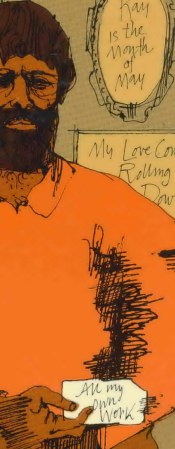 |
a probably partial listing of some of his cover art :
- Babysitters, The : Folk songs for babies, small children, baby sitters and parents
- Vanguard Everyman / SRV-3002/73002 (8/67) (re: of VSR-9042, 1958)
- Bacall, Lauren : Reads James Thurber's The 13 Clocks - Pathways of Sound /
POS-1039, vol.1 (1962?)
- Bach, J.S. : Cantata No.13; Cantata No.166 - Vanguard Everyman / SRV-
244/SRV-244SD (1967)
- Bach, J.S. : Cantata no.78, Cantata no.106 - Vanguard Everryman / SRV-290 /
SRV-290SD (1968)
- Bach, J.S. : Cantata no.80, Cantata no.104 - Vanguard Everyman / SRV-
219/SRV- 219SD (1966)
- Bach, J.S. : Cantata no.95, Cantata no. 33 - Vanguard Everyman / SRV-243/SRV-
243SD
- Bach, J.S. : Cantata no.100, Cantata no.175 - Vanguard Everyman / SRV-
230/SRV-230SD (1967)
- Bach, J.S. - Cantata no. 117 / Cantata no. 93 - Vanguard Everyman Classics /
SRV-241 / SRV-241 SD (1967)
- Bach, J.S. : Cantata no.207A, Cantata no.214 - Vanguard Everyman / SRV-231 /
Srv-231SD (1967)
- Baez, Joan : Ballad book - Vanguard / VSD-41/42 (1972) / Vanguard Midline /
VMS- 73107 (re: disc 1, 1984); VMS- 73115 (re: disc 2, 1984)
- Baez, Joan : Contemporary song book - Vanguard / VSD-49/50 (1974)
- Baez, Joan : The Joan Baez lovesong album - Vanguard / VSD-79/80
- Baez, Joan : The country music album - Vanguard / VSD-105/106 (1979)
- Baroque Christmas cantatas - Vanguard Cardinal / VCS-10045 (1968)
- Beethoven, L.V. - Missa solemnis - Vanguard Everyman / SRV-214/5 / SRV-
214/5SD (1966)
- Brahms, Johannes : Symphony no.1 in C minor, op.68 - Vanguard Everyman /
SRV-221 / SRV-221SD (1967)
- Cahn, Rolf & Eric von Schmidt : Folkways / FA-2417 (1961)
- Davis, Rev. Gary : Rev. Gary Davis at Newport (8/67) (re: of VRS-9214/VSD-79214, 1966)
- Deller, Alfred : Music for a while - The vocal art of Henry Purcell - Vanguard
Everyman / SRV-280SD (1968)
- Deller, Alfred : Sings Elizabethan and Jacobean music : Vanguard Everyman /
SRV-306SD (1971); re: of withdrawn VSD-6532
- Deller, Alfred : Western wind - Vanguard Everyman - SRV-3005/73005 (8/67)
- Dvorak, Aton : Symphony no 5 in E minor - Vanguard Everyman - SRV-
182/182SD (1965) (unsigned ink drawing)
- Dyer-Bennett, Richard : The essential Richard Dyer-Bennett - Vanguard / VSD-
95/96 (1977)
- Evans, Maurice : ... Reads the most of Winnie the Pooh - Pathways of Sound /
POS-1038
- Feyer, George : ...Plays the essential George Gershwin - Vanguard Twofer/ VSD-
61/62 (1974)
- Gottschalk, Louis Moreau - Music for piano, four hands and two pianos (Eugene
List, piano) - Vanguard VSD-71218 (1976)
- Greenhill, Mitch : Shepherd of the highways - Prestige / PR-7438 (1966)
- Handel, G.F. - Alexander's feast or The power of music - Vanguard Everyman
Classics / SRV-282/3 SD (1968)
- Handel, G.F. - Music for the Royal Fireworks; The Water Music - Vanguard / VSD-
71176/ Quad - VSQ-30020 (1972)
- Houston, Cisco : I ain't go no home - Vanguard Everyman / SRV-3006/73006 (re: of
VRS-9107, 6/62)
- Kruth, John : John Kruth's midnight snack - Hopewell Records / HW-06 (1987)
- McCaslin, Mary : The bramble & the rose (w/ Jim Ringer) - Philo/PH-1055 (1977)
- Moreau, Louis : Gottschalk - Vanguard / VSD=71218 (1976)
- Morath, Max : Plays Ragtime - Vanguard Twofer/ VSD-83 / 84 (3/76)
- Morath, Max : Plays the best of Scott Joplin -VSD-39/40 (1972);
- Morath, Max : Max Morath plays the best of Scott Joplin and other rag classics -
Vanguard Midline / VMS-73106 (1973)( an original recording, not a
edited re: of VSD-39/40, despite reusing an edited version of the cover from that
LP)
- Morath, Max: The world of Scott Joplin - Vanguard Everyman / SRV-310 SD
(1973) (reuses an edited-down version of the cover from VSD- 39/40)
- Morath, Max : The world of Scott Joplin, v.2 - Vanguard Everyman / SRV-351
(1975) (note: CD version of this LP features very edited down detail of the
original cover)
- Muldaur, Geoff : Shiver me timbers ! : best of the early recordings - privately
pressed (2003 - CD)
- Muldaur, Geoff & Maria : Sweet potatoes - Reprise MS-2073 (1972)
- Mussorgsky, Modest Petrovich : Pictures at an exhibition - Vanguard Cardinal /
VCS-10116 (1974)
- Odetta : Odetta at Carnegie Hall - Vanguard Everyman - SRV-3003/73003 (8/67)
(re: of VSR-9076, 1960)
- Prokofiev, Sergei : Peter and the wolf - Vanguard - VSQ-30033 {quad} (1974)
(back cover illustration)
- Purcell, Henry - Celestial music / Now does the glorious day appear - Vanguard
Cardinal / VCS-10053 (1969)
- Rebourn, John, Group : Live in America - Flying Fish/FC-27103 (1981)
- Renbourn, John : Ship of fools - Flying Fish / FF-466 (1988)
- Rushing, Jimmy : Listen to the blues - Vanguard Everyman (8/67) (re: VRS-8505, 1955)
- Schlamme, Martha : Raisins and almonds-Vanguard Everyman/SRV-3004(1967)
- Schubert, Franz : Symphony #9 in c major - Vanguard Everyman Classics/SRV-
218 SD
- Schutz, Heinrich : Musikalische exequien - Vanguard Everyman / SRV-245SD
(1967)
- Seeger, Pete : The essential - Vanguard / VSD-97/98 (1978)
- Stravinsky, Igor : Petrouchka - Vanguard / VSD-71177 (1973)
- Van Ronk, Dave : Van Ronk sings - Folkways / FA-2383 (1961)
- (various) : Baroque Christmas cantatas - Vanguard Cardinal / VCS-10045 (1968)
- (various) : Come for to sing (von Schmidt, Hester, Washington, Elliott, Cahn) -
Pathways of Sound / POS-1033 (1963)
- (various) : Negro folklore from Texas State Prisons - Elektra / EKL-296/EKS-7296
(1965)
- (various) : The great blues men - Vanguard / VSD-25/26 (1972)
- (various) : The great blues men at Newport - Vanguard / VSD-77/78 (1976)
- (various) : Greatest folksingers of the sixties - Vanguard / VSD-17/18 (1972)
- (various) : The greatest songs of Woody Guthrie - Vanguard / VSD-35/36 (1972)
- von Schmidt, Eric : Dick Farina and Eric von Schmidt - Folklore/ F-LEUT/7 (1963)
- von Schmidt, Eric : Eric sings von Schmidt - Prestige / PR-7384 (1964)
- von Schmidt, Eric : Who knocked the brains out of the sky - Smash/SRS-67124
(1969)
- von Schmidt, Eric : 2nd right 3rd row - Poppy / PYS-5705 (1972)
- von Schmidt, Eric : Eric von Schmidt and the Cruel Family - Philo/PH-1052 (1977)
- Wagner, Richard : Orchestral music of Wagner - Vanguard Everyman / SR-
220/SRV-220SD (1966)
- Wagner, Richard : Orchestral music of Wagner: Siegfried idyll rienzi - Vanguard
Everyman / SRV-220 / SRV-220SD (1967)
- Wakefield, Frank : End of the rainbow - Bay Records / Bay 214 (1980)
- Weavers : The Weavers' song bag - Vanguard Everyman / SRV-3001/ 73001
(1967)
|
Ó 2002, 2003, 2010 Greg Pennell
last updated : 8 feb'10